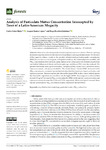Analysis of Particulate Matter Concentration Intercepted by Trees of a Latin-American Megacity

View/
Use this link to cite
http://hdl.handle.net/2183/28415
Except where otherwise noted, this item's license is described as Atribución 4.0 Internacional (CC BY 4.0)
Collections
- Investigación (ETSECCP) [826]
Metadata
Show full item recordTitle
Analysis of Particulate Matter Concentration Intercepted by Trees of a Latin-American MegacityDate
2021Citation
Zafra-Mejía C, Suárez-López J, Rondón-Quintana H. Analysis of Particulate Matter Concentration Intercepted by Trees of a Latin-American Megacity. Forests. 2021; 12(6):723. https://doi.org/10.3390/f12060723
Abstract
[Abstract] Urban areas with trees provide several ecosystem services to citizens. There is a growing interest in ecosystem services for the removal of air pollutants such as particulate matter. The objective of this paper is to show a study on the variation of intercepted particulate matter concentration (IPMC) by tree leaves in the megacity of Bogotá (Colombia). The relationship between IPMC and PM2.5 concentrations observed in air quality stations in two urban zones with different air pollutions was studied. Influences of climate and leaf morphology variables on IPMC were also analyzed. The species under study were Ligustrum-lucidum, Eucalyptus-ficifolia, Tecoma-stans, Callistemon-citrinus, Lafoensia-acuminata, and Quercus-humboldtii. The results showed that leaf IPMC decreased as the PM2.5 concentration increased. Species that best described this trend were Ligustrum-lucidum and Lafoensia-acuminata. These two species also showed the largest IPMC in their leaves. Indeed, species that showed the largest leaf area were those with the highest IPMC. On average, it was observed that for each 5.0 µg/m3 increase in PM2.5 concentration the IPMCs of the species Ligustrum-lucidum and Lafoensia-acuminata decreased by 33.6% and 23.1%, respectively. When wind speed increased, there was also an increase in PM2.5 concentrations and a reduction in the leaf IPMCs.
Keywords
Air pollution
Leaf morphology
Particulate matter
PM2.5
Urban trees
Leaf morphology
Particulate matter
PM2.5
Urban trees
Description
Restrictions apply to the availability of these data. Data was obtained from Red de Monitoreo de Calidad del Aire de Bogotá (RMCAB) and Botanical Garden of Bogotá (JBB), and are available at http://201.245.192.252:81/Report/stationreport (accessed on 6 February 2020) and http://sigau.jbb.gov.co/SigauJBB/VisorPublico/VisorPublico (accessed on 6 February 2020) with the permission of RMCAB and JBB, respectively.
Editor version
Rights
Atribución 4.0 Internacional (CC BY 4.0)






